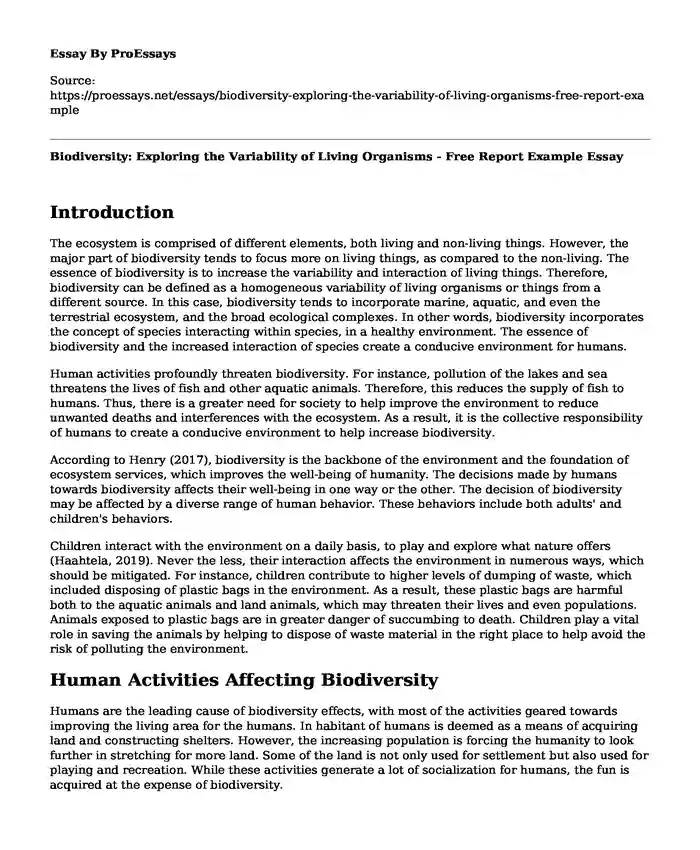Introduction
The ecosystem is comprised of different elements, both living and non-living things. However, the major part of biodiversity tends to focus more on living things, as compared to the non-living. The essence of biodiversity is to increase the variability and interaction of living things. Therefore, biodiversity can be defined as a homogeneous variability of living organisms or things from a different source. In this case, biodiversity tends to incorporate marine, aquatic, and even the terrestrial ecosystem, and the broad ecological complexes. In other words, biodiversity incorporates the concept of species interacting within species, in a healthy environment. The essence of biodiversity and the increased interaction of species create a conducive environment for humans.
Human activities profoundly threaten biodiversity. For instance, pollution of the lakes and sea threatens the lives of fish and other aquatic animals. Therefore, this reduces the supply of fish to humans. Thus, there is a greater need for society to help improve the environment to reduce unwanted deaths and interferences with the ecosystem. As a result, it is the collective responsibility of humans to create a conducive environment to help increase biodiversity.
According to Henry (2017), biodiversity is the backbone of the environment and the foundation of ecosystem services, which improves the well-being of humanity. The decisions made by humans towards biodiversity affects their well-being in one way or the other. The decision of biodiversity may be affected by a diverse range of human behavior. These behaviors include both adults' and children's behaviors.
Children interact with the environment on a daily basis, to play and explore what nature offers (Haahtela, 2019). Never the less, their interaction affects the environment in numerous ways, which should be mitigated. For instance, children contribute to higher levels of dumping of waste, which included disposing of plastic bags in the environment. As a result, these plastic bags are harmful both to the aquatic animals and land animals, which may threaten their lives and even populations. Animals exposed to plastic bags are in greater danger of succumbing to death. Children play a vital role in saving the animals by helping to dispose of waste material in the right place to help avoid the risk of polluting the environment.
Human Activities Affecting Biodiversity
Humans are the leading cause of biodiversity effects, with most of the activities geared towards improving the living area for the humans. In habitant of humans is deemed as a means of acquiring land and constructing shelters. However, the increasing population is forcing the humanity to look further in stretching for more land. Some of the land is not only used for settlement but also used for playing and recreation. While these activities generate a lot of socialization for humans, the fun is acquired at the expense of biodiversity.
Animals and plants that had occupied the area before the human settlement in the region are forced to leave the area. On the contrary, some of the are killed in the process, and others are exposed to harsh conditions that threaten their existence.
While the construction of playing grounds and other socialization parks are highly increasing in metropolitan areas, it is vital for the planning to incorporate a diverse range of biodiversity, through tree plantations to help attract, numerous species to live within the human settlement.
The increasing population of humans has cased for the adoption of radical means of food production, such as the extensive use of fertilizers in growing food. While this is geared towards benefiting the humans, the consequence of these fertilizers is seen when the water bodies are affected and a reduced number of aquatic families are destroyed.
How Children Can Help in Biodiversity
The adults have widely dominated the goal of improving biodiversity over the past years, where youths and adults have taken the steps of conserving the environment and providing food for animals in the environment. Never the less, children have their role to play towards creating friendly and healthy biodiversity. On the one hand, children can take a critical role in biodiversity, is through actively engaging in community practices, such as visiting animals' orphanage to help learn about the environment of animals, and how they interact with humans, as part of the short term program. In this case, children will develop the notion of clearing about animals and their environment, rather than competing with the animals for limited resources.
Through interacting and exposing children to learn about the environment, children tend to learn about the need for conservation of the resources, such as water and proper disposal of waste products. This included the disposal of plastic bags to the right bins, which helps the plastic materials from invading and dominating in the environment.
On the other hand, while the human population continues to increase at a rapid rate, children need to actively participate in fostering long-term solutions in biodiversity conservation. Children should be integrated into the planting of trees, as one of the long-term programs that help and improve biodiversity. Therefore, children have a collective responsibility in promoting and improving biodiversity.
Reference
Haahtela, T. (2019). A biodiversity hypothesis. Allergy, 74(8), 1445-1456. https://doi.org/10.1111/all.13763Henry, T. J. (2017). Biodiversity of Heteroptera. Insect biodiversity: science and society, 1, 279-335. https://doi.org/10.1002/9781118945568.ch10
Cite this page
Biodiversity: Exploring the Variability of Living Organisms - Free Report Example . (2023, Oct 21). Retrieved from https://proessays.net/essays/biodiversity-exploring-the-variability-of-living-organisms-free-report-example
If you are the original author of this essay and no longer wish to have it published on the ProEssays website, please click below to request its removal:
- Risk Communication in Time of Radiation Disaster Essay
- The Relationship Between Weathering, Erosion and Transportation - Research Paper
- Avoiding Outdoor Activities in Polluted Areas Paper Example
- Annotated Bibliography on Global Warming and Global Change
- Research Paper on Pacific Tsunami Warning System: Ensuring Safety for 26 Member Countries
- Offshore Drilling in Louisiana Gulf: Potential Negative Impacts - Research Paper
- Global Warming: Industrial Progress and its Impact on Climate Change - Essay Sample







